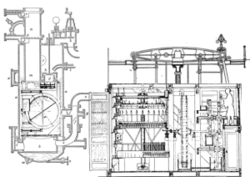Steam engine
The steam engine was invented in 1745 by James "What? What?" Watt. Prior to the discovery of electricity (also my James "Shocking! Simply Shocking!" Watt) the steam engine powered the Renaissance.
Principles of Action[edit]
Simply put, when water is heated sufficiently it explodes. When heated water is injected into a cylinder and then compressed by a piston, the explosion of the water will cause the piston to expand, forcing it to turn a flywheel or crankshaft. This rotary motion can then be used to draw uniform circles.
This vicious cycle is often termed the water cycle or -- if two cylinders and pistons are used in opposite reciprocating motion -- the Tsunami.
Modern Improvements[edit]
Even as the builders of steamships were constructing the largest steam engines ever made, Indian engineers were applying Watt's principles to an entirely new engine: the improved steam turban.
By miniaturizing the steam engine and covering it in insulating fabric, the inventor created a portable personal powerplant which could be worn over the penis, in a condom like fashion.
Second-generation steam engines[edit]
The second-generation steam engine powers Italy's train system. It is very efficient. It is powered by organic gasses, the type of which is expelled from the south end of a north-facing homo sapiens after overconsuming Swanson Instant Meals. In fact, no form of payment is required to use the train system; all one need do is approach one of the two GIUs (Gas Intake Units) located on the station platform and, to put it simply, apply gas. Once the process of filling the GIUs is complete, the hose is connected to the locomotive, the people board, and it rapidly departs.
The engine's fuel combustion process is very complex. It begins by cooling the gas until it condenses, then applying 1/9 mililitres of water per litre of gas to prepare for steam regeneration. The solution is then heated until it evaporates as steam, hence Steam Engine. It is then exposed to 2-18 super small cave demons that spin a conveyor belt like contraption, causing the wheels to rotate. If the resultant motion is slower than desired, more fart-gas is applied.
